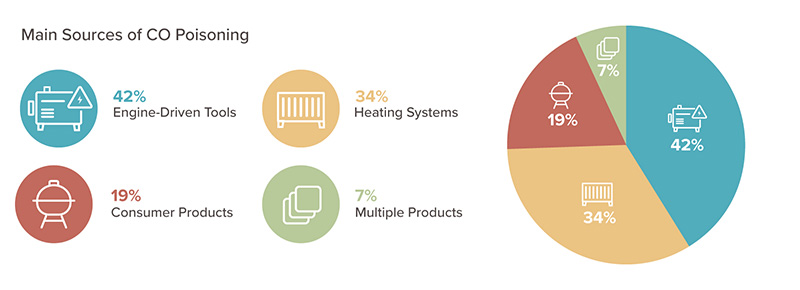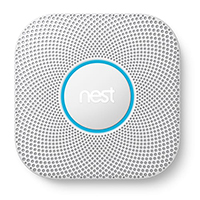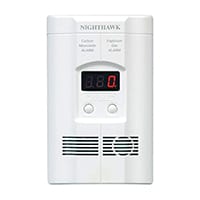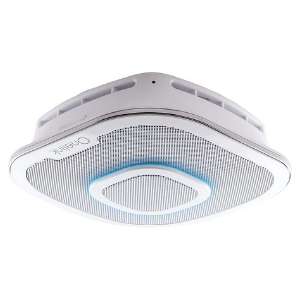From smart home to simple units, we found the best CO detectors to keep your home and family safe.
The Best Carbon Monoxide (CO) Detectors of 2024
SafeWise experts have years of firsthand experience testing the products we recommend. Learn how we test and review.
Nest Protect marries safety features like smoke, fire, and carbon monoxide detection with intuitive smart features. It's also a companion to your home security system and even a nightlight. It's our pick for the best carbon monoxide detector.
Nest Protect comes with an option for voice alerts to minimize panic. And it connects to the Nest app, so you'll get alerts from anywhere. Read on to compare this top carbon monoxide alarm to our other favorites.
Top 5 carbon monoxide detectors
- : Best overall
- : Best voice control
- : Budget pick
- : Easy installation
- : Best value

Riding out a storm? Stay safe and prevent carbon monoxide sickness with these tips:
- Make sure CO and smoke detectors have fresh batteries (or battery backup)
- Never use a generator or a gas/propane heater in the house, garage, or a shed
- Don't use the stove or a grill to heat the house
- Don't run a vehicle for warmth and/or power, especially in an enclosed area
Carbon monoxide detector reviews
1. Google Nest Protect: Best carbon monoxide detector
Nest Protect is a combination smoke and carbon monoxide detection and works with an app. When you download it, you can get alerts to your phone and even silence alarms if necessary. With state-of-the-art sensors for both fire and carbon monoxide, the Google Nest Protect smoke alarm is one of the best for homeowners or renters.
You can't change the batteries in this carbon monoxide alarm, so you'll need to replace the whole thing once it expires. Even at $120, Nest Protect is still a good value if it lasts for its full life expectancy of 10 years.
Learn more in our full Nest Protect review.
2. First Alert Onelink: Best voice control
The First Alert Onelink smart smoke and carbon monoxide detector can do a lot. Using your home’s Wi-Fi, the carbon monoxide alarms can talk to one another and synchronize to alert you if there is a gas leak or fire.
You can also control it from your Apple device through an app, so you can silence the alarm or get notifications on your phone.
This one may have been our pick for the best carbon monoxide alarm, but it's just so pricey.
Onelink doesn't have a battery compartment that you can access, so when it dies you'll need to get a new CO detector. With a price tag over $200, that steep replacement cost might be more than some want to pay.
3. Alert Pro: Budget pick
The Alert Pro carbon monoxide detector alarm is an affordable device with one job—to keep you and your family safe from CO poisoning. And while this cheap carbon monoxide detector doesn’t have any smart features, it does have a powerful 85 dB siren to warn everyone in your home.
It’s also one of the easiest devices to install. Just mount the backplate to the wall, add the batteries (included with the unit), and click the monitor into place. Plus, it comes with a backlit digital display for easy viewing of current carbon monoxide level in your home.
And for around $25, you can afford to add more than one to your home. Place your Alert Pro CO sensor in the basement, kitchen, garage, or anywhere you burn fossil fuels. We even saw reviews from users who kept it in their vehicle.
4. Kidde Nighthawk Plug-in: Easy installation
When we say installing the Kidde Nighthawk carbon monoxide alarm is easy, we mean it. You won't need drills, screws, or even batteries. Just plug it in, and it’s all set. It also comes with a 9-volt backup battery in case of a power outage.
Plug-in options like this gas and carbon monoxide detector keep renters and landlords happy. No need to drill holes in the wall.
Like other carbon monoxide detectors, it comes with a test button and LED screen to show the CO level in your home. When the Nighthawk detects dangerous levels in your home, it will play a signature beeping pattern so you won’t confuse it with any other alarms in your home.
The Kidde Nighthawk model that detects only CO isn't available as of our latest update. Still, we recommend the upgraded version, which also detects the buildup of explosive gases like propane and natural gas.
Loud sirens are the standard for carbon monoxide detectors, but what if someone in your family has hearing loss? Try a specialized smoke and carbon monoxide detector for the hearing impaired, like the First Alert BRK 7030BSL, that triggers a strobe light when there's an emergency.
5. Kidde Battery-Operated: Best value
The Kidde Battery-Operated CO detector checks the air every 15 seconds for continuous monitoring with its electrochemical sensor. It doesn’t rely on hardwiring either, so it will continue to work even during a power outage. To top it off, it has a powerful 85 dB siren that sounds when it senses the poisonous gas.
While it lacks the smart features seen in the Nest and Onelink carbon monoxide detectors, it has all the marks of a reliable device. In addition to its loud siren and consistent monitoring, it has an LCD display. Plus, the green and red light to give visual safety cues to people with hearing loss.
If you need multiple CO detectors, this is a good device to start with. It’s affordable, dependable, and easy to install.
More brands we considered for best carbon monoxide alarm
X-Sense
X-Sense (about $40) is a recent up-and-comer selling attractive CO alarms that compete with long-time leaders like First Alert and Kidde. While the detectors score high customer reviews, especially for wireless interconnectivity, we're waiting until we can test them before adding them to our lineup.
Forensics Detectors FD
Forensics Detectors FD (about $100) makes a handy carbon monoxide alarm for car and truck use—it's a great tool for folks that drive for a living. This travel carbon monoxide detector is more sensitive than ones you'll find in most homes, making it easier to spot emissions issues in the cabin of your truck. Still, the sensor lasts only three years compared to the 10-year life of standard CO detectors.
Klein Tools
Klein Tools' (about $140) handheld carbon monoxide monitor is a diagnostic device an HVAC installer or mechanic would use. But while it's ultra-sensitive, it's not a safety device for the average homeowner.
Amazon Smart Air Quality Monitor
The Amazon Smart Air Quality Monitor (about $70) launched toward the end of 2021 and comes with a wealth of sensors to track indoor air quality: particulate matter, volatile organic compounds, carbon monoxide, humidity, and temperature.
But despite its ability to track CO levels, it's not actually a carbon monoxide alarm for emergencies. Amazon even goes as far as saying you still need a proper CO alarm when using this device. Still, it's got a lot of cool sensors and could be a good companion for an air purifier.
Final word
After hours of research and testing, we’ve found the best carbon monoxide detectors and smoke detector combos available. From basic battery operated to smart carbon monoxide alarm devices, we think the Nest Protect is the best option for most folks. We like its smart home features and the added safety of smoke detection to help keep you safe.
Carbon monoxide detectors FAQ
Check out our full carbon monoxide detector FAQ page to learn more about CO detection.
Carbon monoxide poisoning causes flu-like symptoms like dizziness, nausea, vomiting, headaches, confusion, or fainting.
If you're at home, get out of the house and call 911. CO poisoning doesn't always hit suddenly and doesn't leave your system quickly, so it's a good idea to seek medical attention as soon as you can.
Every year, 400 Americans die from accidental carbon monoxide poisoning and 20,000 are admitted to the emergency room.
Everyone is susceptible to carbon monoxide poisoning, but children, older adults, people who are physically ill, and pets are more likely to be affected by CO.
Carbon monoxide detectors work like smoke detectors but detect levels of carbon monoxide instead.
CO detectors usually have one or more of these sensors:
- Biomimetic detectors use color-changing gels that absorb carbon monoxide which triggers the alarm.
- Metal oxide semiconductors are carbon monoxide sensors that have silica chips that detect CO and send electrical signals to trigger an alarm.
- Electrochemical sensors use electrodes in chemical solutions that sense changes in electrical currents when carbon monoxide is present, and they sound the alarm.
Most professionally monitored security systems come with a CO detector. Check out our top security providers to see which home security systems include CO detectors with their monitoring plans.
Put a home carbon monoxide detector outside every separate sleeping area in your home, your kitchen, basement, and garage. We recommend finding an area far enough away from the carbon monoxide source but close enough to the areas you and your family normally occupy.
Check out our full guide on where to install your carbon monoxide detectors.
Types of carbon monoxide detectors
There are several types of carbon monoxide detectors available for purchase. Some include multiple functions:
- Dual-function: sense different threats like CO, smoke, fire, and gas
- Digital: show you levels of carbon monoxide on a digital screen
- Smart: run diagnostics and sync with home automation apps
- Hardwired: wire into your home’s electrical grid, work unless the power goes out
- Battery-operated: basic sensing and display, need batteries to operate
CO detector maintenance
Most carbon monoxide detectors last an average of five years. Although the product’s lifetime will vary depending on your make and model, you can still get the most out of your detector by wiping it down weekly to keep it clean from dust and debris.
Just like your smoke detectors, it's a good idea to test your CO detector monthly. Start by pressing the “test” button to ensure the siren works. If your detector is older, you can purchase a carbon monoxide meter to find out if your detector is still fully functional. If the carbon monoxide sensor doesn’t go off when you test it, it’s probably time to buy a new one.
Sources of carbon monoxide gas

Image: SafeWise.com
Carbon monoxide (CO) has been called the “silent and invisible killer” because it doesn’t have a smell, color, or taste. It’s one of the most prevalent causes of death due to poisoning in America. Any time you burn something—like gasoline, natural gas, wood, oil, propane, or charcoal—carbon monoxide is released into the air.
In outdoor spaces, this usually isn’t a health hazard because there is enough area for the CO to dissipate, so particles never amount to a toxic level. The danger comes when carbon monoxide is released in a contained area like your home, RV, or garage.
Anything that burns will create carbon monoxide. It’s not just your stove, fireplace, or grill either. Here are some of the things that can create carbon monoxide when turned on:
- Appliances
- Gas grills
- Gas stoves
- Gas or oil-burning furnaces
- Fuel-burning water heaters
- Pressure washers
- Generators
- Non-electric cars, trucks, and boats
- Chain saws
- Non-electric space heaters
- Tools
- Snowblowers
- Lawnmowers
Know what to do and what not to do
Lighting a fire in your fireplace is okay if it’s properly ventilated. However, keep the following in mind or you could cause a dangerous level of carbon monoxide to build in your home:
How we reviewed
With decades of safety experience, we compared smart features, installation ease, and detection accuracy to find the best carbon monoxide detectors. We also looked at user reviews to better understand how these devices work firsthand.
Visit our methodology page to learn more about how we conduct reviews like this one.
Related articles on SafeWise
Disclaimer
Product prices and availability are accurate as of the date/time indicated and are subject to change. Any price and availability information displayed on Amazon at the time of purchase will apply to the purchase of this product. Safewise.com utilizes paid Amazon links.
Certain content that appears on this site comes from Amazon. This content is provided "as is" and is subject to change or removal at any time.
†Google, Google Nest, Nest Protect, and other related marks are trademarks of Google LLC.






